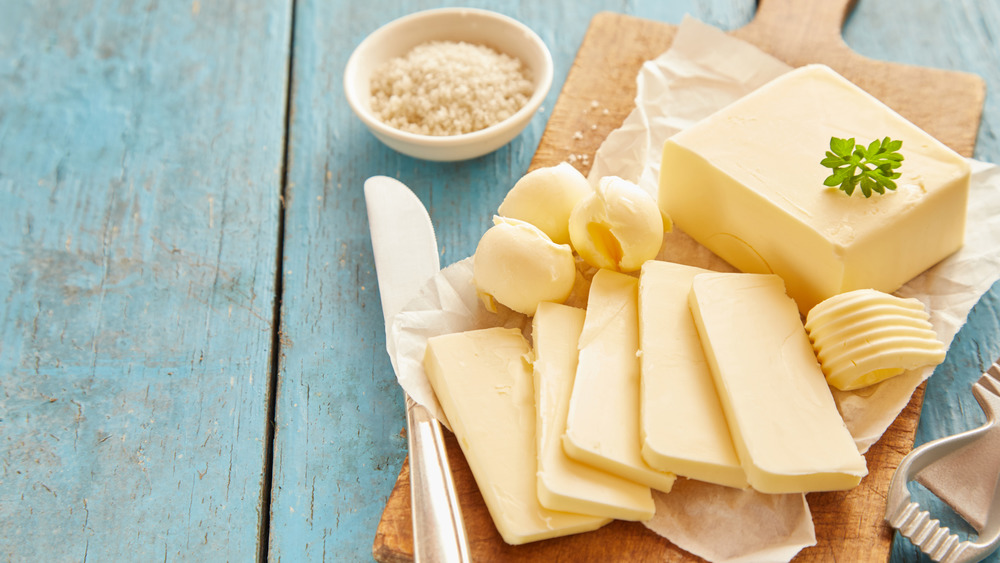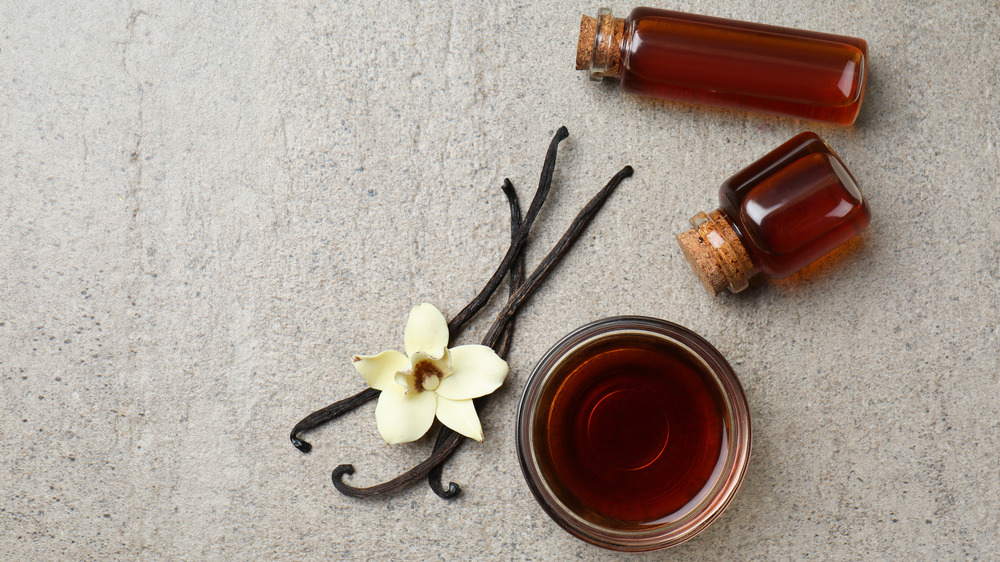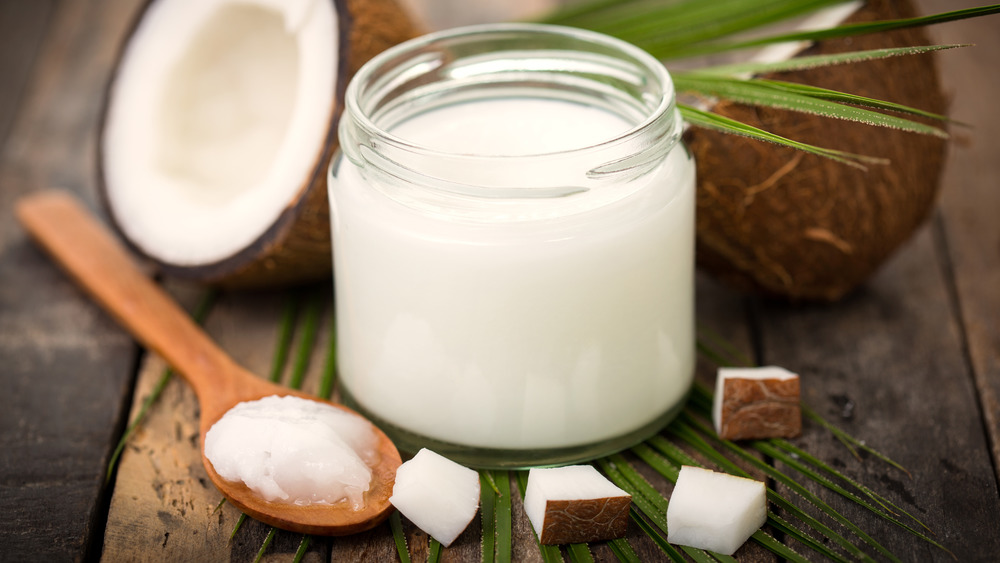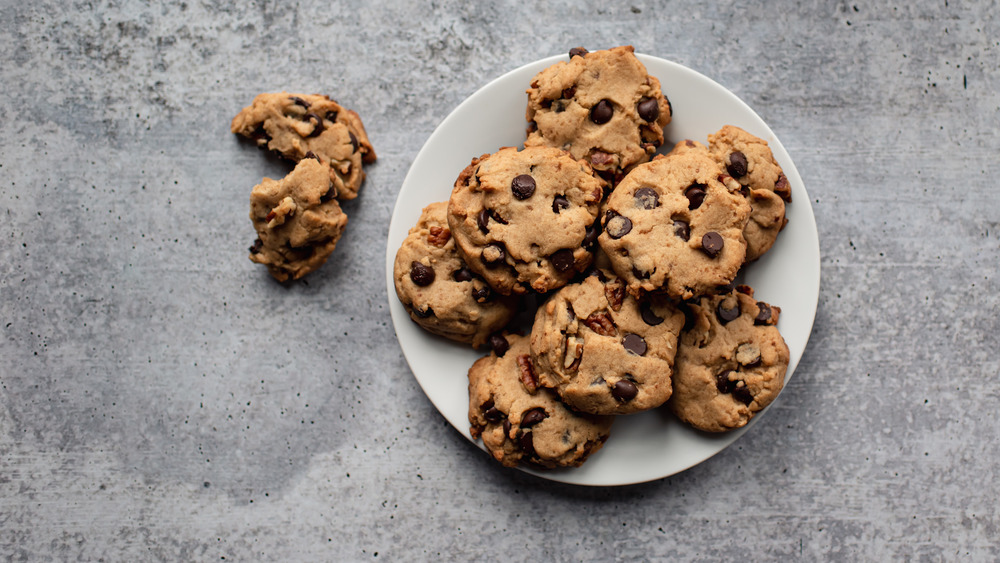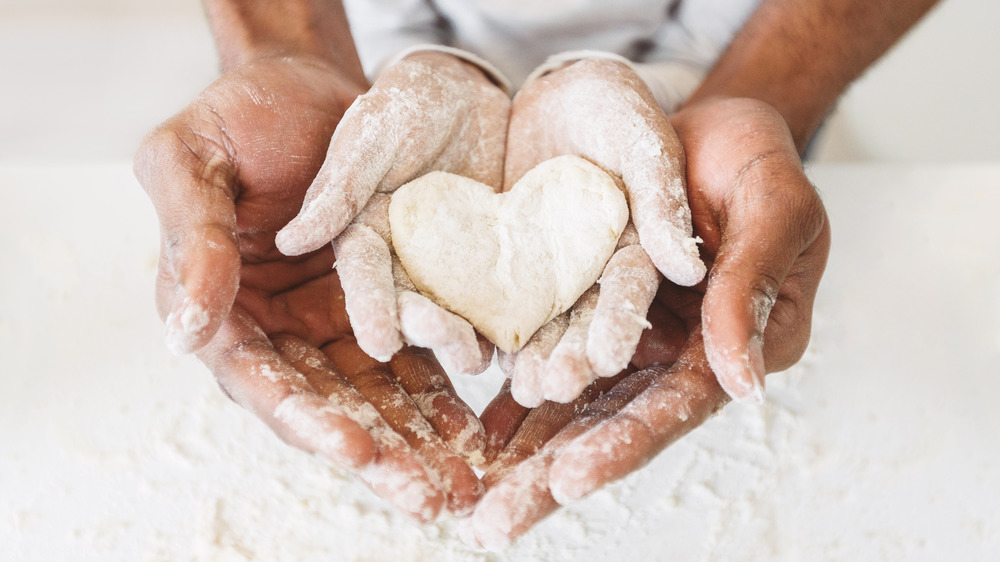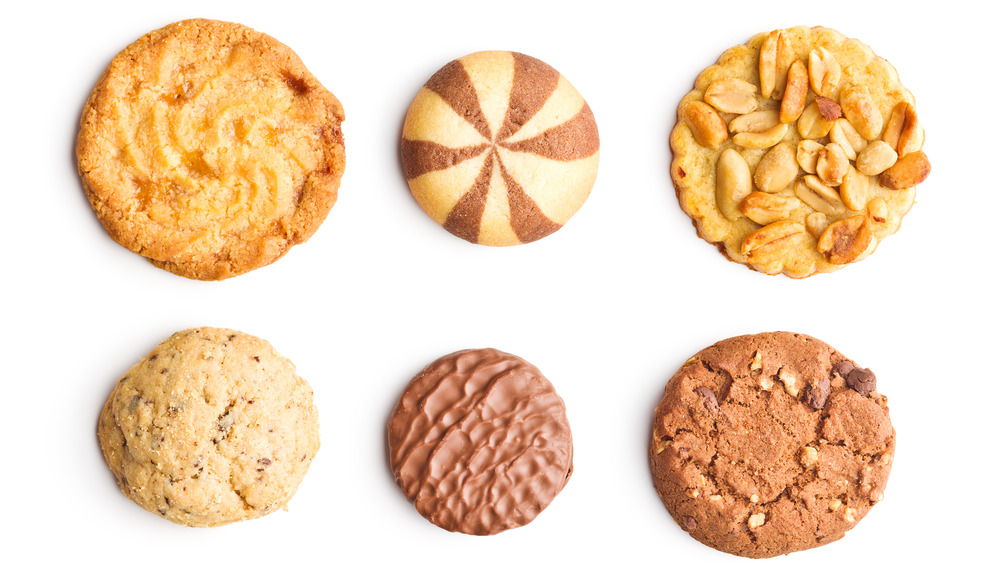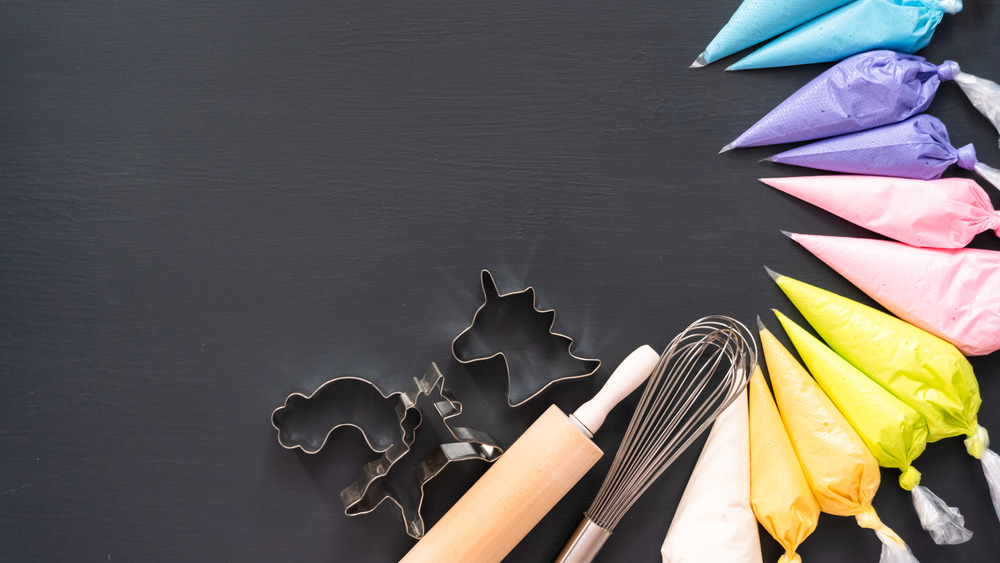Hacks To Make Boxed Cookie Mix Taste Homemade
Unlike cooking, baking is truly a science, and even the smallest tweak to a recipe can ruin a perfectly good dessert and render it inedible. There's something about homemade cookies that evokes a warm, fuzzy feeling like no other. In fact, some realtors used to bake cookies prior to hosting an open house in a bid to make any future buyers feel right at home.
Unlike homemade cookies, boxed cookie mix comes packaged as is, and often lacks a personal touch. All of the dry ingredients, like flour, salt, and baking soda, are already mixed in, meaning all that's left to do is add the remaining wet ingredients — usually butter and/or oil, water or milk, and sometimes, eggs. Luckily, there are plenty of hacks to transform store-bought cookie mix into brag-worthy cookies that, if your friends didn't know any better, would think were homemade. Here are some ways to get creative with your cookies.
Use butter instead of margarine or shortening for a homemade taste
A lot of boxed cookie doughs call for margarine or oil, but homemade cookies, especially shortbreads, are hard to fake without that true, melt-in-your-mouth buttery flavor. Fats from shortening, butter, or oils are what contribute to the overall softness of cookies. Butter, in particular, is the most flavorful fat of the three, but it also has the lowest melting point. If you use butter instead of shortening or oil, not only will your cookies deliver that signature homemade taste, but they'll be crispier and thinner than what the boxed dough promises.
One thing to watch out for is the type of butter you use in your modified cookie dough recipe — butters with half of the sodium content, or low-fat options, for example, could contribute to a change in moisture levels, resulting in a more crumbly or crispy cookie. As a general rule of thumb, always choose an unsalted butter because the boxed dough likely already has salt as an ingredient.
Powdered milk is the secret ingredient in homemade cookies
Milk and cookies are a natural combo. But what about cookies made with powdered milk? According to Lifehacker, adding powdered milk to your store-bought cookie dough can make the final product chewier, and it can also add a slight crust, which helps to lock in moisture. Powdered milk is essentially dehydrated milk. Also sometimes called dry milk, powdered milk has a very long shelf life, and doesn't need to be refrigerated. Therefore, it's still got all of the fat, protein, and flavor, minus the extra liquid that could mess with your boxed cookie dough recipe. Unlike liquid milk, adding powdered milk to your cookie dough will only enhance the flavor, Epicurious says, and you won't have to stress over extra water ruining your cookies. If you do plan on adding powdered milk to your boxed cookie dough, just one tablespoon should do the trick!
Swirl in some pure vanilla extract for a homemade flavor
If you're an experienced baker, you've likely worked with plenty of pure vanilla extract. Not to be confused with imitation vanilla flavor, which uses artificial ingredients, The Spruce Eats reports that pure vanilla extract is derived from vanilla beans, alcohol, and water, and contributes a rich and sweet flavor, without actually adding any extra sugar. Imitation vanilla, on the other hand, is produced using a chemical additive called vanillin.
Pure vanilla extract actually doesn't taste like the vanilla taste we all know and love — it's actually quite bitter! But the cheap artificial stuff has an overpowering, sugary taste, and it's not recommended to be used as an alternative to the real version in your cookies. If you can't get your hands on any pure vanilla extract, you'll need twice the amount of the imitation vanilla to achieve the same flavor profile, according to The Spruce Eats. When used in baking, pure vanilla extract not only adds a familiar vanilla taste, but it can naturally bring out the other flavors in your cookie dough, according to the Huffington Post.
Swap vegetable oil with coconut oil for your cookies
Most boxed cookie mix calls for eggs and butter, but sometimes, the pre-mixed recipes use oil instead. Typically, vegetable oil is used because it has a neutral flavor that won't overpower your final baked product. But, there's another oil out there that can take your pre-packaged cookie dough to the next level. Coconut oil is a wonderful substitute for other oils as well as butter (via The Kitchn).
Although coconut oil comes in liquid and solid forms, it's best to use solidified, room-temperature coconut oil for baking because in its solid state, the consistency is the most similar to butter. There are also different kinds of coconut oil and depending on the kind you use, your cookies might pick up a slight coconut flavor (via The Kitchn). Unrefined coconut oil (virgin) is produced from coconut meat, so it's still very flavorful. Refined coconut oil is processed at a high temperature, which removes the natural taste, so if you don't want the cookies to taste like coconut, this is your best pick!
Make sure the butter is at room temperature for homemade cookies
One of the biggest mistakes you can make when baking cookies is using cold, hard butter. If you're in a rush, taking the butter straight from the fridge might be tempting, but your cookies will suffer. Creaming butter with dry ingredients is easiest when the butter is soft. But easiness aside, using room-temperature butter also plays a crucial role in how your cookies will turn out, Bon Appetit reports. Room temperature butter may be a solid, but it contains air pockets that allow it to be whipped, which then bond it with the flour and sugar when mixing the dough.
If your butter is too hard, you can place it in the microwave to soften it, but be careful not to melt it completely. Melted butter drastically changes the consistency of your cookies. Butter that is too warm won't aerate properly and sticks to the remaining dry ingredients, resulting in a denser, harder cookie.
Add brown sugar for extra chewy cookies
If you've ever baked ginger cookies, you know that molasses is the secret ingredient behind their soft and chewy texture. As it turns out, brown sugar is another secret ingredient. Although boxed cookie dough already has sugar mixed into it, adding a little sprinkle of brown sugar can totally transform the end result. Much like butter and other fat-soluble ingredients, sugars also liquify during the baking process. While white sugar contributes to a crispy, crunchy cookie, brown sugar does quite the opposite, and will make your cookies soft and chewy, says Delishably. The reason? Brown sugar also contains molasses and retains more liquid than white sugar, which will help your cookies retain moisture while baking in the oven.
According the Detroit Free Press, brown sugar also has a higher acidity than processed white sugar due to the added molasses, which will help your cookies turn out fluffier, too! If you plan on adding a little bit of brown sugar to your boxed cookie mix, make sure you mix it in with your dry ingredients, before adding in wet ingredients.
Chill the cookie dough first
One of the main reasons people turn to store-bought cookie dough rather than making cookies from scratch is the convenience of it all, reports Insider. Making your own cookies generally takes one to two hours total, from the time you start mixing the ingredients, to the baking period itself. But when you use boxed cookie dough, that time is sliced in half! With extra time on your hands, one of the best ways to make your boxed cookie dough taste more like the real thing is to chill the dough before dropping the cookies on the baking sheet, Taste of Home suggests. Sticking the cookie dough in the fridge for just 30 minutes can make all the difference in the world because it keeps your cookies from spreading out too quickly in the oven. Nothing is worse than having to break cookies apart after taking them out!
Chilling your cookie dough also cools down the fats that are in the dough, which allows the cookies to spread out slower and keep their fluffy shape. If you need any more convincing, chilled cookie dough also has more flavor, since the dry ingredients have more time to soak up the other ingredients, like butter, vanilla, and that brown sugar we mentioned earlier!
Adjust your cookie bake time at the five-minute mark
Different kinds of cookies call for different bake times, as The Spruce Eats points out. The majority of cookies have a baking temperature that's set to 350 degrees, but as it turns out you can make time adjustments based on how crispy or chewy you want your cookies to turn out.
The type of baking pan you use, as Livestrong points out, will also impact the overall softness or hardness of your cookies. Dark baking pans absorb heat at a faster rate than lighter pans, and therefore, your cookies will cook faster. If you're using a darker baking pan, it's a good idea to take a peek at your cookies before the timer goes off to ensure they're not already done, or, worse, burning! If you want your cookies a little bit crispier, Food Crumbles recommends leaving them in for slightly longer than the original recipe calls for — just make sure you don't take them out too early, or they might deflate!
Try adding in nuts, sprinkles, or chocolate chips to your cookies
Following the recipe on a boxed cookie mix recipe is simple enough. But if you're the kind of baker who likes to improvise, you might be tempted to stray from the instructions posted on the back of the box. Part of the fun behind making cookies (regardless if they're from scratch or not) is creating a treat that's all your own. Adding additional ingredients to the dough, like chocolate chips, nuts, or sprinkles not only makes your cookies visually appealing, but it can change the overall flavor profile, too!
If you do plan on mixing in some add-ons, remember that certain nuts and chocolate will increase the amount of oil in the dough. It's also a good idea to thoroughly mix the additional ingredients into the dough to ensure even baking times. As Insider points out, dumping additional ingredients into the mix haphazardly could ruin the entire recipe. You'll want to ensure that all of the dry ingredients and the wet ingredients are thoroughly mixed to avoid any air pockets or undercooked cookies.
Add toppings to the cookies
Decorating your cookies isn't just reserved for the holidays! Adding toppings is a fun way to give boxed cookies a homemade feel because you can put a custom spin on the final product that's all your own. Toppings like colorful rainbow sprinkles, drizzles of caramel or chocolate, or candies are all great ideas, and they'll add an extra crunch or deliciousness to your cookie! Other unconventional toppings, like a dash of sea salt, can even change the entire flavor profile of your cookie (via The Kitchn). There's a reason why we have an obsession with salted caramel everything, after all!
Other toppings to transform your boxed cookies into something special can include crushed pretzels, powdered icing sugar, crushed walnuts, melted chocolate, and even a sugary cereal, like Fruit Loops or Lucky Charms. If you're really after a homemade feel, you could also try your hand at making homemade icing, and drizzle it on your cookies once they've completely cooled.
Cut the cookies into cute shapes
Adding extra ingredients, like chocolate chips, nuts, or extra vanilla extract can make your boxed cookies taste more homemade, but what about making them look homemade, too? Using cookie cutters to create cute, custom shapes is an easy way to make boxed cookies stand out. This is especially fun if you're making the cookies for a special occasion, like a themed birthday or bachelorette party, or a bridal or baby shower, as there are plenty of cookie cutters that will suit all of these themes.
If you plan on using cookie cutters, instead of spooning and dropping the cookie dough onto a baking sheet, you'll need to roll it out with a rolling pin first. Thickness matters when rolling cookie dough, so be careful not to flatten them too much, or you'll end up with a crispier cookie, as opposed to a nice soft, gooey one! Once you've cut the cookies into their desired shapes, you can play around with decorating ideas, like using a combination of colored icing (add a couple drops of food dye to your vanilla icing) and sprinkles.

